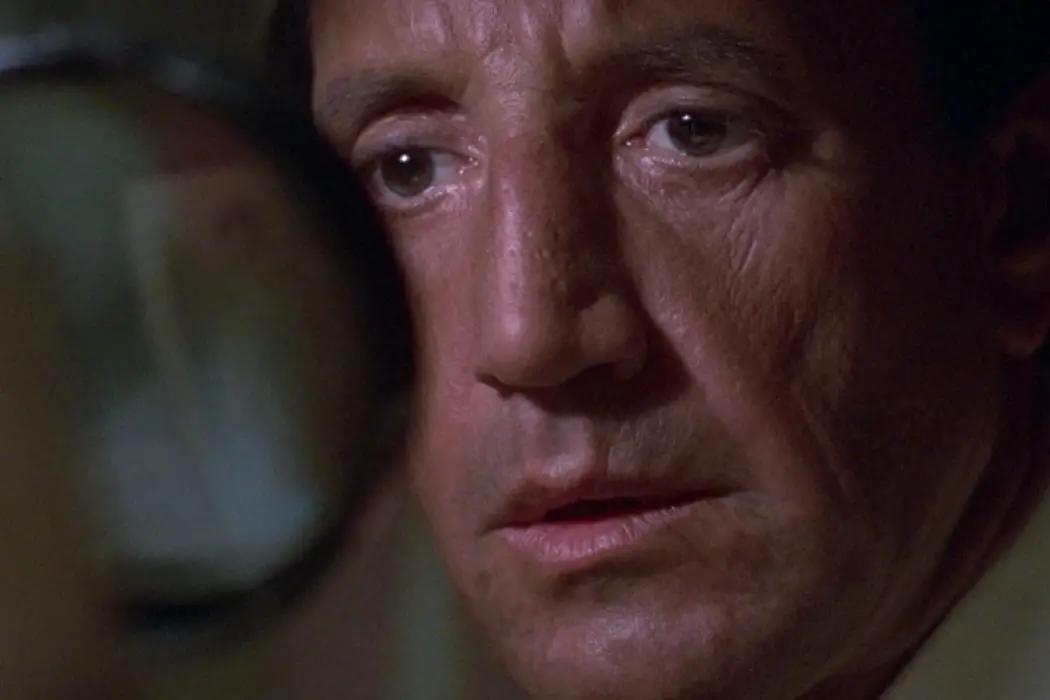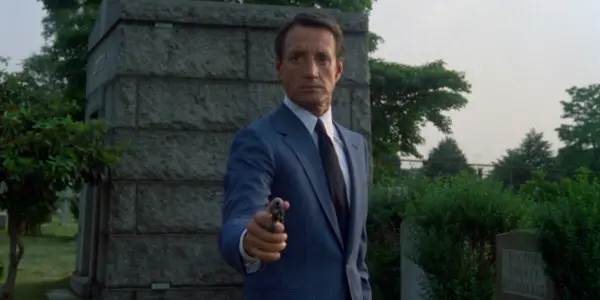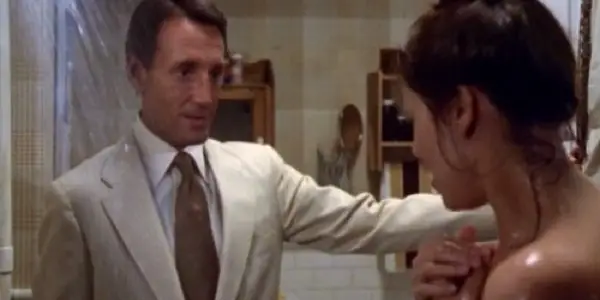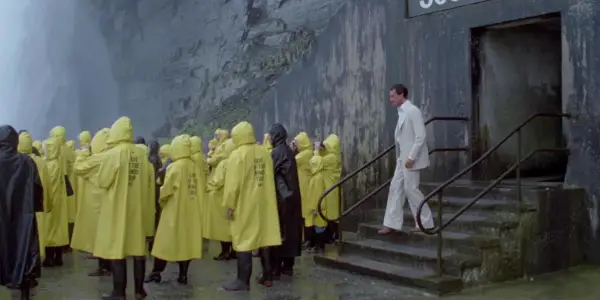She Looks Back #1: Jonathan Demme’s LAST EMBRACE

Brian Brems is an Associate Professor of English and Film…
When Alfred Hitchc*ck directed his final film, Family Plot, in 1976, the world around him had changed mightily from his earliest days working in silent film in England. A full blown cultural upheaval was in the midst of rewriting the rules of music, television, and most relevant to him, cinema. This new filmmaking environment both fueled and was fueled by the changes taking place outside the movie theatre as well, as protests over the Vietnam war radicalized a generation of young people and invested them with a committed, though temporary, hostility to authority. Civil rights struggles for black Americans, gay people, and women took center stage. New sexual freedoms led to the collapse of the old Hollywood order’s repressive Production Code, which restricted the content allowable on screen, in favor of the much more permissive ratings system. Revolution was in the air.
The filmmakers who came of age watching films on the big screen and eventually, from their living rooms on television, came to form a New Hollywood generation of self-aware, self-conscious, self-designated auteurs, many of whom sought to mix their reverence for classic Hollywood film genres and filmmakers with their equally weighty attraction to international art cinema, and create a new style of mainstream film. The films of this period would coopt old genres, old stories, old styles, infuse them with a bit of the era’s cultural pessimism and cynicism, and thus, breathe new life into the very medium they were thought to be killing.
For these filmmakers, Hitchc*ck loomed large. As Brian De Palma, Robert Benton, Paul Schrader, and Alan J. Pakula crafted dark thrillers, conspiracy-driven tales of wrong men accused, the paranoia a product of the Nixonian era, they borrowed heavily from Hitchc*ck’s stories and styles, internalizing the aesthetic and repurposing it for their own ends. One of the younger members of this generation, Jonathan Demme, got his start working for exploitation producer and landmark film history figure Roger Corman in 1974 with the women-in-prison shlocker Caged Heat.
By 1979, Demme took a bigger step into the mainstream with Last Embrace, a pseudo-spy thriller starring Roy Scheider as disgraced and traumatized special agent Harry Hannan. An adaptation of a novel called “The 13th Man,” a Hitchc*ckian title if there ever was one, the film lifts its narrative from his similar stories of men on the run like Saboteur, The Man Who Knew Too Much, and North by Northwest. The film also draws heavily upon singular visual references, like a stray pair of scissors, which recall a crucial weapon in Dial M For Murder, and a parodic reference to the most iconic moment from Hitchc*ck’s entire career, the shower scene from Psycho. Most crucially for the generation of New Hollywood filmmakers, though, is Hitchc*ck’s Vertigo, his dark tale of obsession and confession; Last Embrace, like many of the films that came out in this period, can’t seem to get the ghost of Vertigo out of its mind.
And yet, Last Embrace, dismissed both then and now as a somewhat empty exercise in simple homage to Hitchc*ck, is more complicated than it seems. Demme’s implementation of Hitchc*ckian style wears the mask of deferent, adherent homage; however, his deft undermining of those visual tropes rips the mask away, and exposes the exploitation of women at the heart of those films.
The Wrong Man
One of the clearest of Demme’s subversions comes in the representation of government covert operative Hannan, the film’s ostensible protagonist. In the film’s prologue, set six months before the main action, Hannan is in a tropical café with his wife when men burst in, recognize him, and she is killed in a shootout. He has foolishly mixed his private and professional lives, and his wife pays the price. As the film fades to black on its slow-motion, nearly wordless, orchestral-score driven cold open, Harry holds his wife’s lifeless body in his arms, in total despair.
The narrative really begins when Hannan returns from a leave of absence, presumably having spent the intervening months in a psychiatric hospital recovering from his traumatic experience and the death of his wife. After a paranoid episode on the platform of a commuter train in which he threatens an innocent passenger, he returns to his New York City apartment to find it occupied by graduate student Ellie Fabian (Janet Margolin), who is subletting the space while doing research for her dissertation. After initial confusion, the two reach a rapprochement, and agree to share the apartment temporarily. Harry’s paranoia continues to dominate his return, as he discovers that the unnamed spy agency to which he belonged seemingly has no use for him, and now regards him suspiciously.

Hannan increasingly comes to believe the agency is trying to kill him, a fear that escalates after he is confronted by Dave Quittle (Charles Napier) at the cemetery, a fellow agent and his deceased wife’s brother. Quittle blames Hannan for her death, and cryptically vows revenge. The complexity of the plot deepens when Harry narrowly avoids cyanide poisoning in his own home; he pops what he thinks is a sleeping pill after a panic-inducing nightmare, but spits it out after recognizing the taste. He and Ellie try to uncover the secret behind who wants him dead, which seems to have something to do with a note he receives that reads “Avenger of Blood” in Hebrew. A string of deaths, each tied to Jewish legend, was accompanied by a similar note, and Harry believes he may be next.
This all sounds like a fairly traditional Hitchc*ckian story; the nefarious spy agency with little regard for the individual man’s life recalls North by Northwest, and the traumatized hero walks in the footsteps of those troubled Hitchc*ckian men from Spellbound, I Confess, and of course, Vertigo. Demme spends an extraordinary amount of the film’s running time laboriously aping Hitchc*ck in nearly every way. This homage climaxes in the movie’s centerpiece action sequence, a cat-and-mouse gun battle between Hannan and Quittle in the bell tower on the campus of Princeton University. The winding staircase places the action firmly in the locus of Vertigo’s mission bell tower, where that film concludes so memorably with the hero reliving his own failure to save his beloved.
One of Demme’s most ostentatious choices in this sequence is Hannan’s desperate move to save himself from Quittle; the assassin has crawled amongst the bells near the tower’s summit, and Hannan turns them on, their clanging and banging echoing through the tower and deafening his attacker. Quittle clutches his head, screaming in slow motion terror, as though the sound of the bells were not just piercing his ears but his mind, too. Quittle succumbs to madness, slips, and falls to the floor of the tower, which Demme captures through highly subjective cinematography, including separate point of view shots. In one, we see through Quittle’s eyes as the floor rushes up to meet him, and in the other, actor Napier’s body is attached to the falling camera, which stares up at him, the ceiling and walls fading away into the background while he screams in terror. These Vertig-inous flourishes coalesce into an operatic, heightened sequence, the kind at which Hitchc*ck himself excelled.
And though these Hitchc*ckian conventions scream out the movie’s influences at a deafening volume, Demme has some surprises yet to come.
The Gaze
A few scenes before Hannan and Quittle’s bell-tower battle, Hannan attends a wine mixer at the invitation of Ellie’s mentor, Professor Richard Peabody (John Glover), from whom the pair have sought expertise on the Hebraic notes. Hannan waits among the academics, standing near a roaring fireplace, apart from the others at the party. Suddenly, the door opens and a woman in a brilliant red dress enters, catching his eye. It’s Ellie, striding towards him in a picturesque encapsulation of the Male Gaze, a term coined by feminist film scholar Laura Mulvey in her groundbreaking essay, “Visual Pleasure and Narrative Cinema.” Mulvey’s critique, which included Hitchc*ck’s films as a prime example, argued that the subject of classic Hollywood film was nearly always male, while women occupied the object position. In her formulation, men (guided by the directorial eye of the almost always male director) were granted the power to look, while women were defined by their “to-be-looked-at-ness.”

Recall the consequential scenes of the last third of Vertigo, when Jimmy Stewart’s Scotty Ferguson is remaking Judy (Kim Novak) into the carbon copy of his lost love, Madeline (also Novak), while we watch him watch her. If she just changes her clothes. Just change her hair color. Just one more thing – put the hair up. Then, walk out of the bathroom into a hazy green light, and he can stare at her, as if she exists only for his visual pleasure, so that he might imagine her, see her image forever in his mind. Because he can look at her, he can possess her.
In Last Embrace, while Harry stands watching Ellie glide into the elegant room where the party is being held, Demme invites the audience to identify with his gaze as he watches her. The scene plays out traditionally, the way a trained audience member, especially in a film so obviously sailing in the wake of Hitchc*ck, to look. It feels like we should look at her, just as he does, seeing her as a romantic partner for the first time. She’s ditched her glasses, tossed off her frumpy graduate student clothes. Here, she conforms to the traditional standard of beauty that characterized so many women on screen who entered parties just like this, just this way, for so many years before her.
But then, the first of many of Demme’s reversals happens. One of Demme’s signature visuals is the direct-address close-up, wherein his characters stare directly into the camera lens as they deliver lines of dialogue. These close-ups, shot straight on and forming an eyeline match with both the character’s scene partner and the audience, appear throughout Demme’s filmography, often to startling effect. Most memorably, he uses these close-ups in his crowning achievement, The Silence of the Lambs, to capture the intensity of the intimate exchanges between serial killer Hannibal Lecter (Anthony Hopkins) and FBI recruit Clarice Starling (Jodie Foster). These close-ups lay bare the actors’ souls, as we, audience members, and the characters who see each other, gain closer access to them than a traditional eyeline barrier might provide.
Last Embrace may contain the first of these close-ups. As Harry stares at Ellie, she looks across the room at him, making eye contact with the camera and Hannan. Then, Demme cuts to the reverse shot. Scheider looks directly into the lens as Demme dollies the camera towards him, matching the pace of Ellie’s approach. In this moment, we do not see what Hannan sees – we see through her eyes, see him staring at her. She looks back.
As It Seems
This reversal sets the stage for the film’s second half, wherein secrets are revealed. The plot of Last Embrace is so complex, so convoluted, so contradictory, that it seems almost to achieve a level of post-modern deconstruction. In a nearly parodic rendering of a Hitchc*ckian set of MacGuffins and Wrong Men and Shadowy Organizations, the expected genre conventions and plot contrivances begin to fall away. Suddenly, we are not in the movie we thought we were in.
The most disorienting moment of the film takes place in a hotel room overlooking the raging waters of Niagara Falls, the setting of a classic 1950s Technicolor noir, Niagara, that drew comparisons to Hitchc*ck both in its own time and in ours. Inside the room, strewn with clothes, a man and a woman meet for a mid-afternoon tryst. He is in his underwear, sitting in one of the room’s chairs. She sits at a vanity mirror, dressed in slinky black lingerie. The camera floats up, and we see her face in reflection – it’s Ellie. Or is it? She’s made up. She’s teased her hair differently. She’s wearing a red streak of shimmering lipstick. She calls herself Eva. She’s expressing herself with a sexual confidence heretofore unseen. Her voice sounds breathy, deliberately meant to inspire lust in the man she’s with.

It is Ellie. It is Ellie wearing that enticing outfit. It is Ellie wearing that makeup. It is Ellie flaunting her sexuality. It is Ellie holding her paramour’s head under the water in the bathtub, pushing down with all her strength against his thrashing, until he downs. It is Ellie.
From here, the film slowly reveals itself. This has not been a story of an accused and paranoid man, Hannan, chased by a spy organization bent on wiping him out. This has been a story of one woman, Ellie, and her quest to avenge in blood the women who have been exploited, forced into prostitution, and often left to die, by a group of men who used them and then discarded them.
Hannan discovers the truth when he finds a photograph in Ellie’s Princeton office of her grandmother, Eva. They look exactly the same. Ellie has been behind it all – she killed the other men, the descendants of the cabal of pimps who made a prostitute of her grandmother. She wants these men to pay in blood for the sins of their grandfathers, who escaped punishment for what they did to her grandmother. Hannan is the grandson of one of these men, and marked for death by Ellie. It wasn’t a nefarious covert agency; there is no international intrigue; the spycraft is totally incidental to the narrative. Harry, like us, is in a different movie than he thought.
The film opens with Hannan’s trauma, just as Vertigo does, as Scotty’s fear of heights leads to the death of a fellow police officer. And we are meant to sympathize with that trauma, follow it through with Harry, right up until the moment that the film reveals an earlier, more structurally-infused, superseding trauma. The trauma of men who lose the women they possess, as Hannan does in the opening moments, is little compared to the trauma of women who have been possessed by those men.
The film’s final act, a deliberate restaging of Vertigo’s, takes place at Niagara Falls. It is the site of Ellie’s bathtub drowning, which recalls her attempt to exercise her own legacy of generational trauma. It is also a reflection of Hannan’s attempt once again to control Ellie, as he drives her there without telling her their destination. When she leaps from the car and flees into the Falls’ visitors’ center, he gives chase, just as Scotty chases Judy up the stairs in the mission bell tower. Hannan eventually finds Ellie in the tunnels beneath the Falls. He comes at her with murderous rage, replaying his generational legacy. His grandfather did violence to Ellie’s grandmother. And so, the legacy continues on, unchanged. She trips, and falls backward. Hannan grabs her hand, but she slips through his fingers, and plummets into the cascading water behind her, lost in the roar of Niagara Falls.
With each Hitchc*ckian homage, and every postmodern story that references and deconstructs old films, there must be purpose. Those references and deconstructions must add up to something greater than the individual parts, or they serve little purpose other than to remind audiences of roads already traveled, ground already covered. As Hitchc*ck’s films are assessed from the perspective of their complicated gender dynamics, it is also worth examining the ways in which his descendants engage with his legacy. Some adhere to it unquestioningly, reiterating old ways of telling stories from old points of view. Others adopt the stylistic signatures of his films without thinking much about the larger representational implications of those techniques. But, the most interesting post-Hitchc*ck movies challenge that legacy using the very tools that made him such an innovator. They use the cinematic language he created to open up new ways of seeing. Last Embrace, forgotten though it may be, deserves a second look.
What other films which follow in the footsteps of Hitchc*ck challenge his work in similar ways? Tell us your thoughts in the comments below!
https://www.dailymotion.com/video/x54w1xb
Does content like this matter to you?
Become a Member and support film journalism. Unlock access to all of Film Inquiry`s great articles. Join a community of like-minded readers who are passionate about cinema - get access to our private members Network, give back to independent filmmakers, and more.
Brian Brems is an Associate Professor of English and Film at the College of DuPage, a large two-year institution located in the western Chicago suburbs. He has a Master's Degree from Northern Illinois University in English with a Film & Literature concentration. He has a wife, Genna, and two dogs, Bowie and Iggy.













